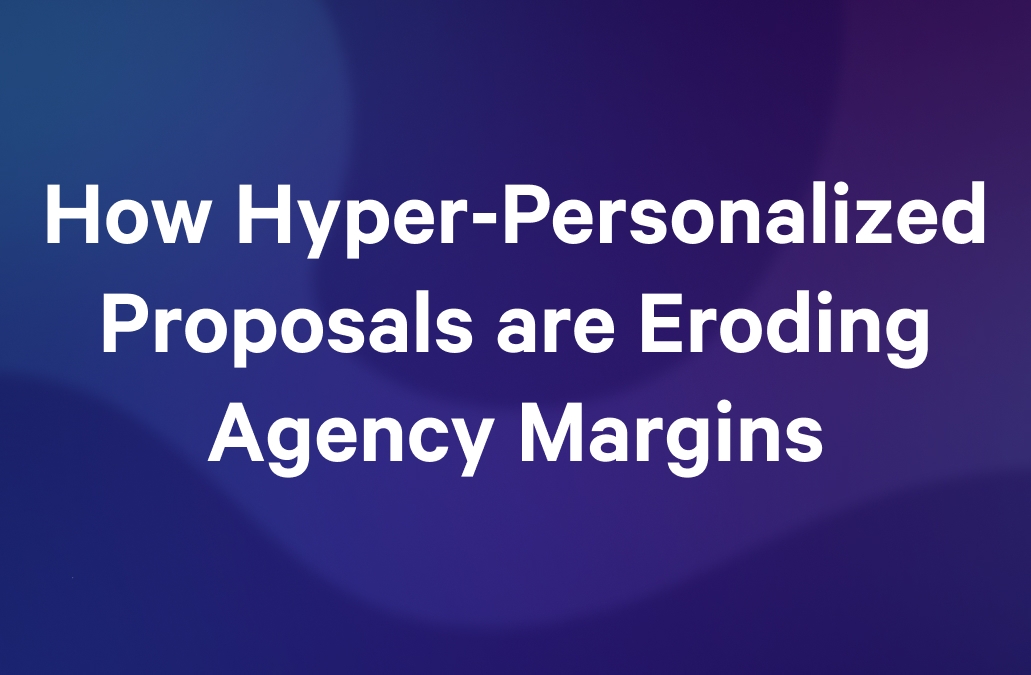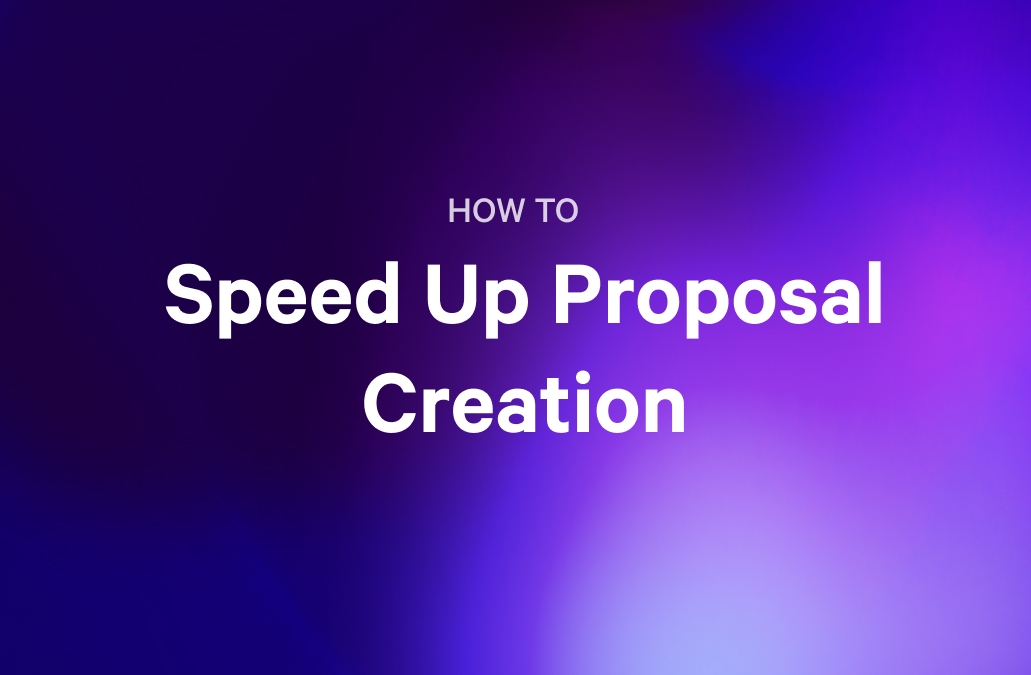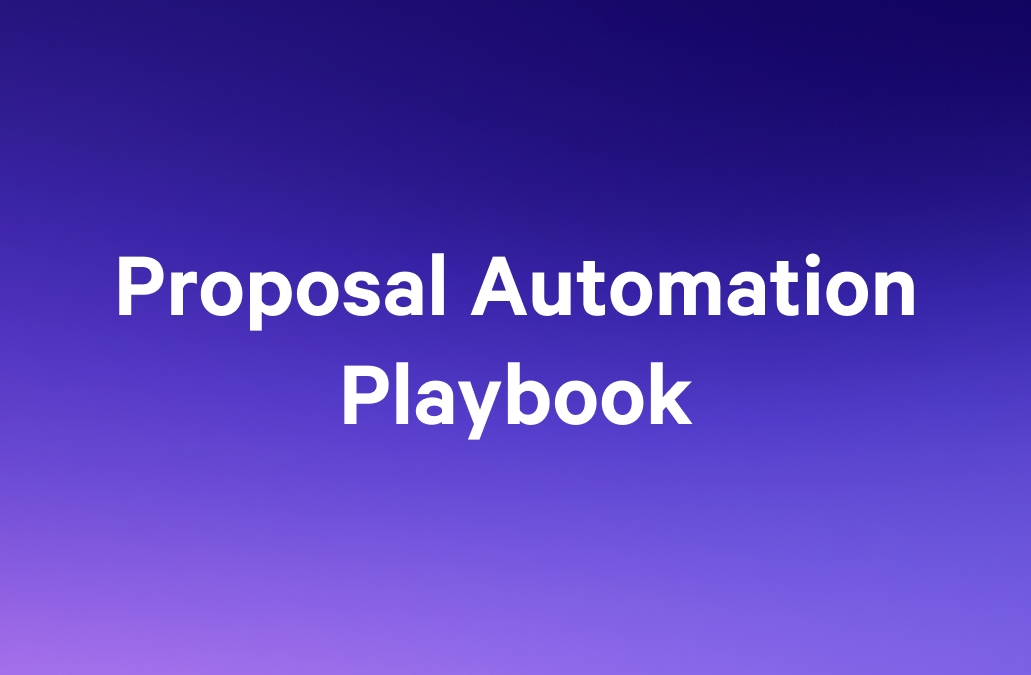Remember that weekend you poured into a “dream client” proposal?
You tailored every section. Added their logo to seventeen slides. Researched their competitors. Even recorded a personal video to stand out.
Then they went with the agency that was 30% cheaper. Or worse… They ghosted.
Better templates and shinier decks won't fix this. The problem is you're sending proposals to people who were never serious buyers to begin with.
The solution is getting pickier about who deserves them. I spoke to agency leaders who’ve built systems to do exactly that—here’s what they’ve learned.
The hidden cost of late-stage qualification
When agencies qualify prospects only after investing hours in custom sales proposals, the damage extends far beyond wasted time. Qualifying prospects is the second-most challenging aspect of the sales process for agencies.
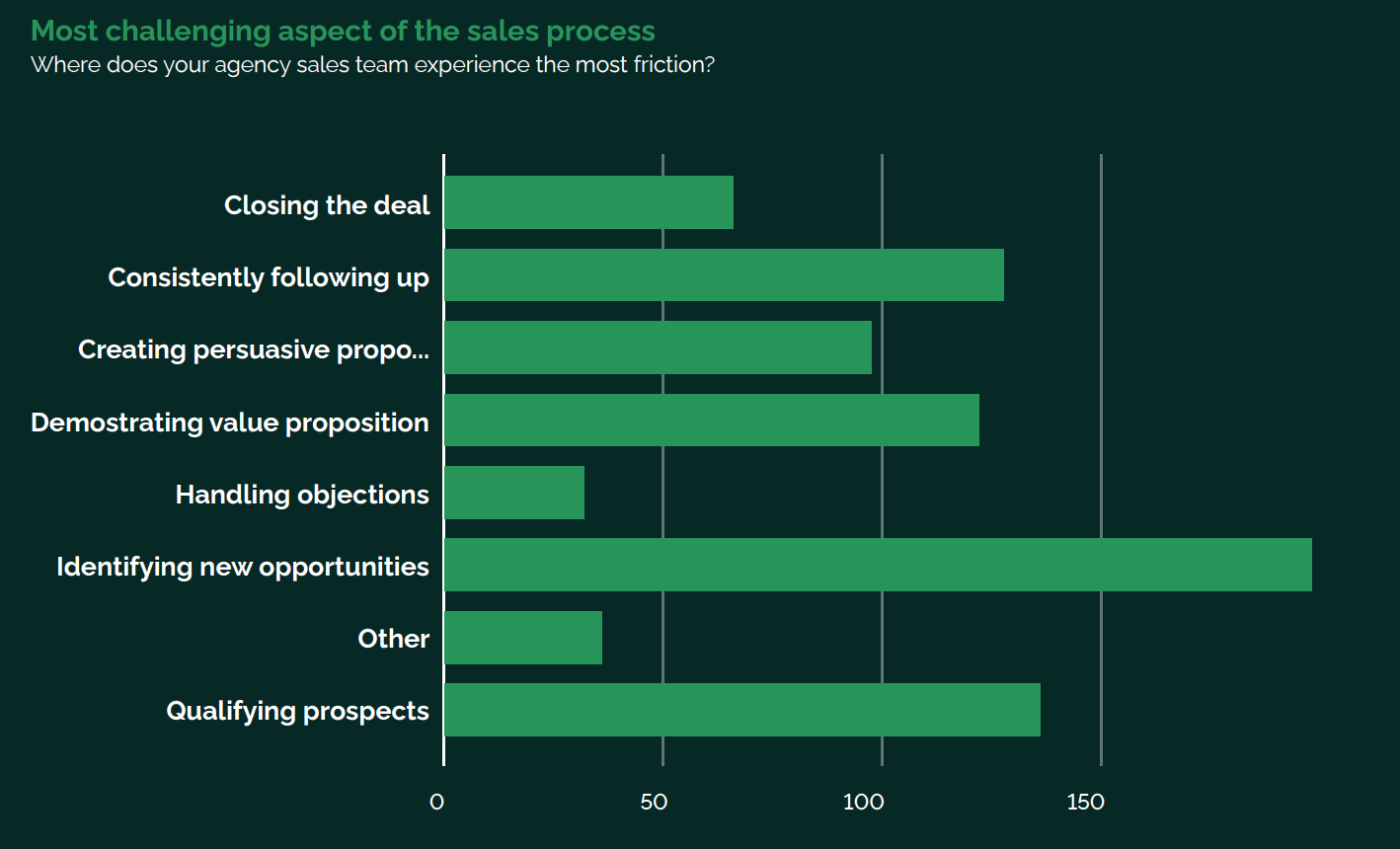
Late-stage qualification creates a cascade of problems that erode team morale, strain client relationships, and ultimately hurt your bottom line in ways that aren't immediately obvious.
The time trap
The time trap is simple: agencies invest their most valuable resource—senior team bandwidth—into elaborate proposals before confirming the prospect is ready to buy.
This traps your top performers in 10 to 20 hours of custom presentations for prospects who may never buy, draining time from paying clients and growth opportunities.
Damien Elsing, Founder of HubSpot Partner Consulting Agency CLCK puts it bluntly:
"The biggest time-waster has traditionally been the customization of proposals – structuring them, fine-tuning, and adding line items for prospects who hadn't even confirmed they had a budget."
Jonathan Pritchard, CMO and previously the Senior Marketing Consultant at Thrive Internet Marketing Agency, calculated how each proposal required 30 minutes to an hour of customization time. He also saw his team falling into the exact same trap.
"Sending proposals to people who have no intention of signing it is a waste of time," he realized. “All that time putting together customized proposals, explaining and framing everything perfectly, then doing all the follow-up afterward."
The math is devastating. If your senior strategist spends 15 hours on a proposal that had a 10% close rate from the start, you've just burned $3,000 in opportunity cost. Multiply that across your team, and you're looking at six-figure annual waste on unqualified prospects.
When good proposals fail for bad reasons
Sometimes you deliver exactly what the prospect asked for, and still lose. The problem isn’t always the quality of your proposal.
William Maxwell Le Normand, Founder of Webflow production agency, Ish.Studio recalls a large project his team felt sure they’d win:
“We sent a strong proposal and invested heavily in it. They needed our services, but it fell through. We hadn’t spent enough time building a relationship in the early meetings. They were busy internally, and we didn’t clearly explain that we only needed two to four hours of their time.”
William's experience highlights a broader issue that many agencies face. As Damien put it: "When proposals aren't won, it's usually due to misalignment and not fully understanding what the client meant."
Even the most well-created proposal falls flat if you skip the upfront work of discovery and relationship-building since you’re making recommendations without knowing the whole story.
The psychological trap
Agencies get caught in a dangerous mindset: if a prospect asks for a proposal, saying no feels like walking away from an opportunity. There's an almost compulsive need to "prove yourselves" by showing how much you care through elaborate customization.
But when someone says "send me a proposal and we'll decide," they're often shopping, not buying. That phrase creates a false sense of urgency, making you feel like speed and effort will win the day.
The reality is different, though. Serious prospects want deeper conversations first. Those who immediately request proposals are typically in the early stages of research and are comparing options without clear criteria or confirmed budgets.
Three frameworks to help you qualify prospects early
Qualifying prospects upfront requires a repeatable system. These frameworks give you clear criteria for evaluating opportunities and the confidence to pursue only the prospects worth your time. Here are three frameworks experts recommend.
The BANT foundation
BANT (Budget, Authority, Needs, Timeline) is a qualification framework that helps agencies avoid chasing prospects who can’t realistically buy.
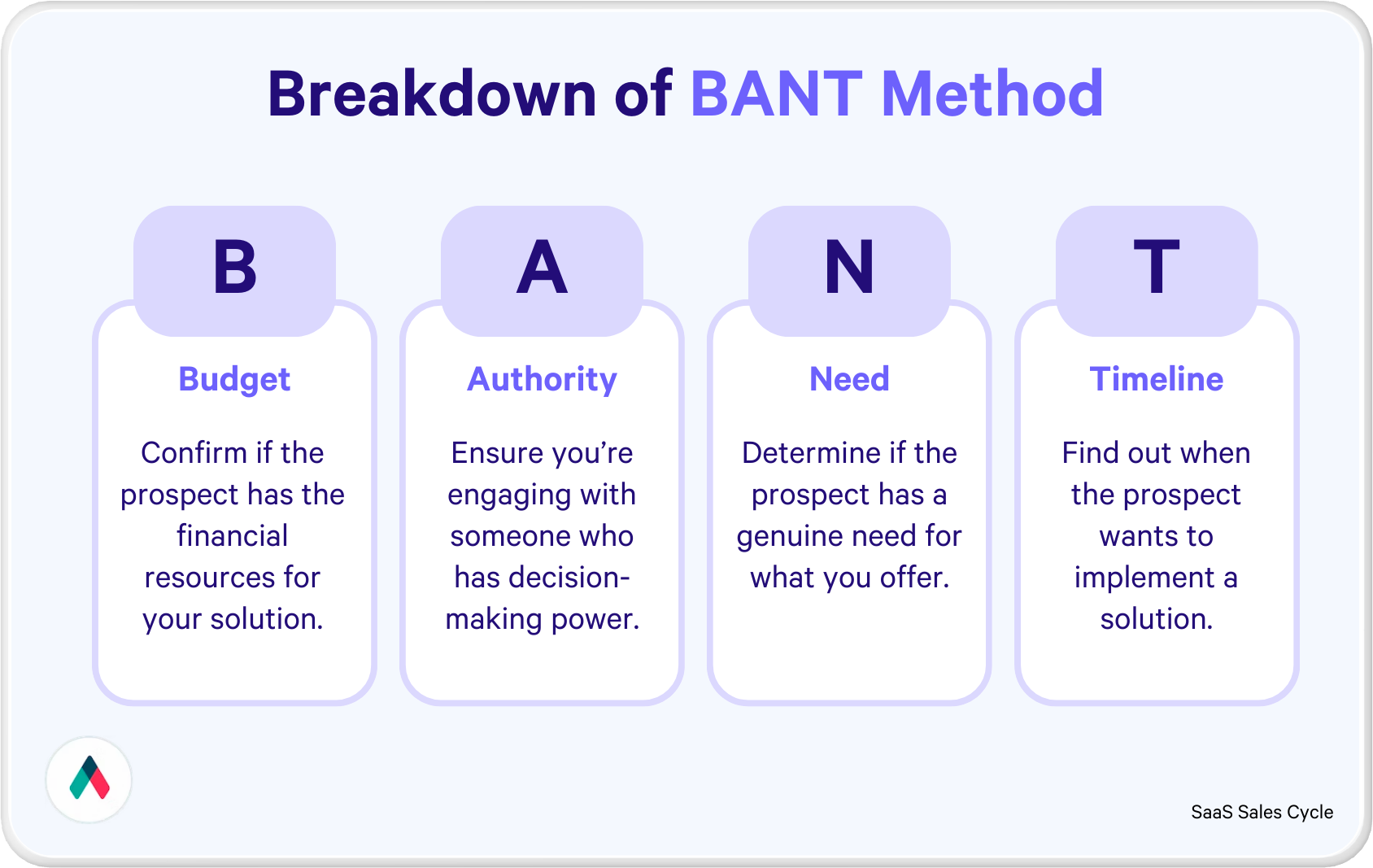
It zeroes in on the four factors that determine purchase readiness rather than interest level.
Damien has built his agency’s entire process around it:
"We use the BANT framework. There's usually at least one qualifying call and the second call is often to present the solution, with the proposal formalizing that discussion."
Their qualifying questions go straight to the essentials:
- What is this problem costing you?
- How urgent are the needs?
- Do you have a budget set aside for this project?” or “Do you have a budget in mind?
These questions confirm financial capacity, decision-making authority, a real business problem, and a workable timeline. BANT works best for higher-ticket projects where budgets, decision-makers, and timelines are clearly defined early in the sales process.
The three-question knockout test
Sometimes you need to skip the small talk and quickly gauge if a prospect is serious. Two agency leaders have honed simple, high-impact question sets that surface buying intent in minutes.
John Paul Casillas, Account Executive at Qwilr, uses three knockout questions to get to the essentials:
- Do you have a budget allocated for a solution like this?
- How long has this been a challenge for your team?
- Who else in your org sees this as a priority or pain point?
In a few minutes, he knows the budget reality, urgency level, and whether there’s internal alignment.
On the other hand, Head of Sales at Qwilr, Aaron Horton, approaches from a buyer psychology angle:
- Why do you think our product is potentially a good fit for you?
- Tell me about the last time you purchased a similar tool.
- What pain are you trying to solve with our product?
Both methods make prospects show their work. If someone can’t explain why they reached out, how they’ve handled similar decisions, or who else is invested in solving the problem, they’re not ready to buy. Serious buyers come with context, urgency, and internal backing, and these questions show them fast.
The elevator test
Beyond budget and authority, there’s a qualification filter most agencies overlook: Do you actually want to work with this person?
Jonathan uses what he calls the elevator test. The elevator test works best when you already have a steady pipeline and can afford to prioritize long-term fit over short-term revenue.
He asks: “If I got stuck in an elevator with this person for 12 hours, could I survive it?”
It’s a lighthearted question with legit implications. You’re about to enter a months-long relationship with hours of meetings, calls, and collaborative work. If someone is already demanding, dismissive, or exhausting in discovery calls, they won’t become easier once they’re a paying client.
Cultural misalignment leads to more revisions, longer meetings, constant expectation management, and a higher risk of public criticism, no matter the results.
Agencies that say no to poor cultural fits, even when the budget is tempting, protect their team’s morale, efficiency, and reputation.
How to rebuild your qualification framework
Your current qualification process probably evolved by accident—a mix of inherited habits, trial and error, and whatever seemed to work last quarter.
Building an intentional framework means designing a system that protects your team's time while identifying the prospects most likely to become great clients. Here's how to overhaul your approach step by step.
1. Choose your budget conversation strategy
Budget conversations can be uncomfortable, but they're the fastest way to separate serious prospects from window shoppers. Create a consistent approach that matches your positioning and comfort level.
When prospects push back on budget questions, our experts suggest three proven approaches:
The direct approach
Some agencies prefer cutting straight to the point. John Paul shares ballpark pricing immediately: "Our pricing is feature + seat count dependent, so a quick answer helps us both."
This approach cuts through games and saves time for both parties. It works best with straightforward prospects and transactional relationships where speed matters more than relationship-building.
The consultative approach
Other agencies take a more educational stance. Aaron positions budget discussions as client protection: "I can give you a huge range of pricing, but I don't think that would help you make an informed decision."
Acting as a consultant frames you as protecting them from bad decisions rather than just trying to close a sale. It's ideal for complex solutions and longer sales cycles where building customer trust is essential.
The commitment-first approach
Jonathan has learned to address the elephant in the room directly by asking the uncomfortable question early: "Are you going to sign it? Otherwise, it doesn't make sense."
This approach requires confidence and a healthy pipeline, but it eliminates the guessing game entirely. You'll know within minutes whether you're talking to a buyer or a browser.
2. Handle the "send me a proposal first" demand
When prospects say, "Just send me a proposal and we'll decide," you have three options that depend on your business model and positioning.
- The “send it” strategy: John Paul believes in transparency: "If they want to see a proposal, I send it. It's the best way for them to review, share, and get buy-in internally." The approach works when you have standardized services with clear pricing structures and need to move quickly through high-volume opportunities.
- The “hold-it-back” strategy: Jonathan takes the opposite approach, only sending proposals after receiving verbal commitment. The strategy protects against tire-kickers and ensures you're only investing time in serious prospects.
- The middle ground: Aaron bridges both approaches: "I can give you indicative pricing after I ask you a few more questions... Is that fair?" The middle ground provides helpful information while still qualifying the opportunity properly.
Choose your approach based on your business model:
| Business Model | Qualification Strategy | Why it Works |
|---|---|---|
High-volume, standardized services | Send it | Speed matters more than customization. Prospects need to see standard packages to make quick decisions. |
Custom, high-touch engagements | Hold it back | Your time investment is significant. Verbal commitment filters out browsers and protects your resources. |
Complex stakeholder environments | Middle ground | Multiple decision-makers need information to build internal consensus, but you still need to qualify properly. |
3. Refine your discovery conversations
Discovery conversations are 30 to 60-minute calls designed to understand a prospect’s situation before you commit to proposal work.
You dig into their challenges, budget, timeline, and decision-making process to confirm whether the opportunity is worth your team’s time. They’re your best filter against unqualified prospects.
Jonathan puts it perfectly: "The quality of your proposal is defined by the quality of your first conversation."
He's learned that the best salespeople follow a simple rule: "Spend the whole first conversation asking them about them." When you focus entirely on understanding their situation, challenges, and goals, you understand their buying readiness, decision-making authority, and internal urgency.
Aaron has systematized this approach by making discovery a prerequisite for proposal work: "We generally don't put together a proposal until we have a timeline and know what to include in it."
Then he asks the key question that separates browsers from buyers: "Can you confirm that's where we are here?"
That single question forces the commitment conversation upfront, ensuring you only write proposals for prospects who've already mentally committed to moving forward.
4. Reframe the proposal's purpose
Think of proposals not as tools to persuade, but as formal documentation of agreements you’ve already secured in discovery and qualification.
Old mindset: Proposal = sales tool to win them over
New mindset: Proposal = confirmation of what’s already been agreed
When the qualification is thorough, proposals become an administrative step rather than a high-stakes pitch. As one agency leader puts it, “If the earlier steps are done right, you shouldn’t be losing many proposals at this stage.”
Before writing a proposal, confirm you can check every box:
□ You can summarize their problem better than they can
□ You have verbal agreement on the solution approach
□ Budget is confirmed and timeline agreed
□ All stakeholders are identified and aligned
5. Learn to identify red flags
Red flags are early warnings that a prospect may waste your time, drain resources, or turn into a nightmare client. Recognizing them early means you can avoid spending weeks on proposals for deals that won’t close, or close but create months of friction.
They generally fall into three categories:
Obvious red flags
Some red flags hit you immediately. Jonathan watches for unrealistic expectations:
“If I hear something like, ‘We expect results in a week,’ that’s an immediate red flag. We can’t even finish onboarding in that time—getting logins, gathering details—it’s just not realistic.”
Immediate disqualifiers include:
- Unrealistic timelines (“We need this live next week”)
- Impossible budgets (“Can you match Fiverr pricing?”)
- Misunderstanding what you actually offer
- Demanding spec work or free audits upfront
- Aggressive price haggling before you’ve proposed
Subtle red flags
These subtle sales buying signals hint at low urgency, misalignment, or decision-making delays. John Paul looks for coded language:
“We’re still early in discovery” (code for: not urgent, not prioritized), hesitation to book a follow-up or vague next steps, and lots of “maybe” language or committee decision-making with no clear owner are all subtle red flags. If they’re not moving fast, they’re probably not moving at all.”
Other quiet warning signs:
- Constantly rescheduling or canceling calls
- Asking for “ballpark estimates” with no real details
- Multithreaded sales with clashing priorities
- Mentioning they’re “shopping around” or “getting more quotes”
- Struggling to explain the business impact of their problem
Counter-intuitive red flags
Aaron’s most surprising warning sign is over-enthusiasm, especially early on:
“If they’re more excited than I am in the first conversation, that’s a red flag. I’ve seen enough good and bad fits to know it’s too soon for them to be certain it’s a perfect match.”
Prospects who rush to commit often haven’t done their homework, lack internal buy-in, or are running from a crisis that will soon become your problem.
Other counterintuitive signs:
- They agree with everything you say (no pushback)
- Immediate “yes” to your first meeting request
- Oversharing personal or company problems
- Praising competitors while courting you
- Asking for references before sharing their own needs
Fast proposals for the right prospects
Early qualification helps you build a business that attracts buyers with budget, urgency, and decision-making power. People who respect your process from day one.
But qualification is only half the equation. Once you've identified the right prospects, you need a proposal system that keeps up.
Qwilr helps you build polished, modular proposals quickly, so you’re not wasting time when a qualified prospect is ready to move.
When smart qualification meets smart proposal automation, you get the best of both worlds: the confidence to be selective, and the speed to act before momentum fades.
Your team’s weekends are too valuable to spend on long shots.
Qualify early. Move fast. Work with people who are ready.
About the author

Kiran Shahid|Content Marketing Strategist
Kiran is a content marketing strategist with over nine years of experience creating research-driven content for B2B SaaS companies like HubSpot, Sprout Social, and Zapier. Her expertise in SEO, in-depth research, and data analysis allow her to create thought leadership for topics like AI, sales, productivity, content marketing, and ecommerce. When not writing, you can find her trying new foods and booking her next travel adventure."
